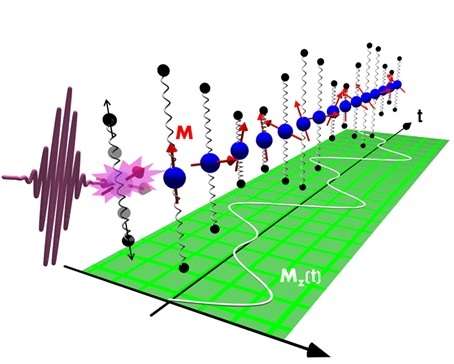Magnetization can surf on the top of a laser-induced sound wave

An effective coupling between magnetism and light can be mediated by sound. This newly discovered phenomenon could be important for recording data on a magnetic device with the help of light. Physical Review Letters publishes the finding of a team from Radboud University (Netherlands) and Taurida National University (Crimea) in their issue of April 11.
Controlling the magnetic state of media with the help of light may be the best way to develop a new generation of magnetic data storing devices. The problem, however, is to find an effective mechanism for optically controlling magnetism. Indeed, according to quantum mechanics the strongest effect in light-matter interaction is the effect of the electric field of light on the electrons, suggesting that some net magnetization must be conserved.
An international team of scientists from Nijmegen (the Netherlands) and Simferopol (Crimea) has discovered a very effective method of optically controlling magnetism: an intense and ultrashort (shorter than 100 femtoseconds) laser pulse excites electrons in a medium to such an extent, that the excited electron-clouds push the atoms off, thereby bringing them in motion and launching a sound wave.
The fact that the sound wave can effectively couple to the magnetization is well known. Unexpectedly, the scientists found that the optically launched sound at the frequency f is accompanied by a response of the magnetization at the frequencies f, 2f and 3f. Such a phenomenon is called anharmonicity. Any pendulum becomes anharmonic if the deviations from the equilibrium become large.
"The fact that the laser-induced oscillations of the magnetization are anharmonic is very intriguing. It means that the coupling of light with the magnetism is very effective and we are getting close to our dream – to record magnetic information with the help of light" says Alexey Kimel, Associate Professor and research group leader at Radboud University, the Netherlands.
It is remarkable that the scientists observed this effect in iron borate. This material is very similar to hematite – one of the cheapest magnets and widely spread minerals. "For optical experiments green iron borate is much more convenient than black hematite, while the magnetic phenomena in those crystals are very similar."
More information: "Laser Excitation of Lattice-Driven Anharmonic Magnetization Dynamics in Dielectric FeBO3." D. Afanasiev, I. Razdolski, K. M. Skibinsky, D. Bolotin, S. V. Yagupov, M. B. Strugatsky, A. Kirilyuk, Th. Rasing, and A. V. Kimel. Phys. Rev. Lett. 112, 147403 – Published 9 April 2014. journals.aps.org/prl/abstract/ … ysRevLett.112.147403
Journal information: Physical Review Letters
Provided by Radboud University Nijmegen




















